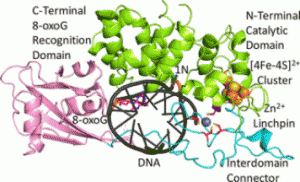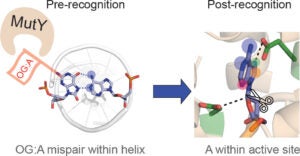Home » Posts tagged 'Mutyh'
Tag Archives: Mutyh
Recent Article Published: Unique H-bonding of Adenine with oxidatively damaged base 8-oxoguanosine enables specific recognition and repair by DNA glycosylase MutY.
Recent Article Published by Sheila David’s Lab: Unique Hydrogen Bonding of Adenine with the Oxidatively Damaged Base 8-Oxoguanine Enables Specific Recognition and Repair by DNA Glycosylase MutY.
Majumdar, C.; Mckibbin, P.L.; Krajewski, A.E.; Manlove, A.H.; Lee, J.K.; David, S.S.
J. Am. Soc. 2020. 142, 48, 20340–20350.
DNA repair protein MutY employs specific interactions to differentiate OG:A basepairs from canonical G:C and T:A basepairs. Prior work from our lab has focused on understanding the structural requirements of OG on lesion recognition and catalysis, and we have shown that MutY relies on the exocyclic 2-amino group of OG to identify and distinguish OG:A from other basepairs. Additionally, we’ve shown that OG binding induces conformational changes that influence A excision.
This new work uses structure-activity relationships (SARs) to identify the structural features of A that influence OG:A recognition, verification, base excision, and overall cellular repair. We correlate observed in vitro MutY activity on A analogue substrates with their experimental and calculated acidities to provide mechanistic insight into the factors influencing MutY base excision efficiency. Our results herein can be used to guide future design of MutY/MUTYH specific probes to monitor the activity, or lack thereof, of MutY/MUTYH variants. These results can also applied toward the development of MUTY/MUTYH specific inhibitors that may find utility in cancer therapeutics.
Click on the link or graphical abstract to find out more!
https://pubs.acs.org/doi/abs/10.1021/jacs.0c06767#
New Manuscript Published: The Zinc Linchpin Motif in the DNA Repair Glycosylase MUTYH: Identifying the Zn2+ Ligands and Roles in Damage Recognition and Repair.
New Manuscript Published: The Zinc Linchpin Motif in the DNA Repair Glycosylase MUTYH: Identifying the Zn2+ Ligands and Roles in Damage Recognition and Repair.

A recent publication from the David, Siegel and Lim (Academia Sinica, Taiwan) labs (Nuñez et al., JACS, 2018) provides insight into the coordination sphere and critical role of a Zn2+ metal binding site in the DNA repair glycosylase MUTYH. Genome database mining and sequence alignment of MUTYH orthologs, along with computational modeling, identified and supported Zn2+ ligation by four Cys residues. Three of the Cys residues lie in an interdomain connector region unique to mammalian MutY enzymes, while the 4th Cys is located in close proximity to the Fe-S cluster DNA binding domain. The functional consequences of reduced Zn2+ chelation on MUTYH-mediated DNA repair activity evaluated using a battery of in vitro and cell-based assays revealed the importance of Zn-coordination in recognition of the damaged DNA substrate. The critical nature of the “Zinc Linchpin Motif” suggests additional functions unique to higher organisms in damage signaling and crosstalk with other DNA repair pathways.
More information at https://pubs.acs.org/doi/10.1021/jacs.8b06923.
Source:
J. Am. Chem. Soc. 2018, 140, 13260-13271.
Keywords: #Muty #Mutyh #BER #DNA #DNARepair #ZincLinchpinMotif #Zn2+ #8OG #DavidLab #UCDavis
Just Accepted Manuscript: Structure Activity Relationships Reveal Key Features of 8-Oxoguanine:Adenine Mismatch Detection by the MutY DNA Glycosylase
7/20/2017
The recently accepted manuscript, Structure Activity Relationships Reveal Key Features of 8-Oxoguanine:Adenine Mismatch Detection by the MutY DNA Glycosylase, was accepted for publication in ACS Chemical Biology.
MutY, remarkably, is able to specifically recognize and initiate repair of target OG:A mismatches from among a vast sea of natural DNA. To help reveal molecular features of OG that are critical for MutY recognition, this work explored the effects of systematic OG:A substrate alterations on MutY recognition in a cellular context. OG analogs were synthesized, assembled into OG:A modified oligonucleotides, and structure activity relationships were investigated using binding and cellular repair assays. Read the article to find out more about how specific OG modifications effect MutY glycosylase activity. Click here for the article: http://pubs.acs.org/doi/abs/10.1021/acschembio.7b00389.
Keywords: #Muty #DNA #DNARepair #BER #ModifiedNucleosides #Enzymes #8OG #DavidLab #UCDavis #glycosylase
Congratulations to Doug Banda and coworkers!
5/31/2017
Congratulations to David Lab authors Doug, Nicole, Michael, and Katie on their recently released article, “Repair of 8-OXOG:A Mismatches by the MUTYH Glycosylase: Mechanisms, Metals and Medicine,” in Free Radical Biology and Medicine! The final version of the article is now available online.
Link to their new article here: https://authors.elsevier.com/a/1V8Lr3AkHAI6DS.
